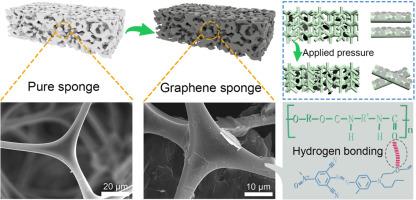Gr/EC纳米复合材料改性高性能压力传感器用导电聚氨酯海绵
IF 6.3
2区 材料科学
Q2 CHEMISTRY, PHYSICAL
引用次数: 0
摘要
聚氨酯海绵具有多层孔隙结构、高压缩性和低模量等优点,是一种很有前途的柔性传感器材料。然而,实现简单的宏观组装,同时实施创新的界面工程来解决固有的非导电性和界面粘附性差的问题仍然是一个挑战。本文通过设计一种由嵌套结构和导电骨架组成的石墨烯/乙基纤维素改性聚氨酯海绵(Gr/EC@PS),展示了一种克服这一问题的通用界面组装策略。得益于纯化骨架表面与乙基纤维素之间的氢键相互作用,以及海绵基质内石墨烯纳米片的机械联锁,Gr/EC@PS压力传感器的传感性能得到协同增强。因此,优化后的传感器不仅具有3.83 kPa−1的灵敏度和在宽压力范围内的快速响应/恢复时间(80.6/124.0 ms),而且具有长时间稳定性(在20 kPa压力下,循环2000次),超过了大多数先前报道的海绵型传感器。提出的协同界面工程方法为推进柔性可穿戴电子产品建立了一个新的范例。本文章由计算机程序翻译,如有差异,请以英文原文为准。

Conductive polyurethane sponge modified with Gr/EC nanocomposite for high-performance pressure sensor
Polyurethane sponges with multilevel pore structure, high compressibility, and low modulus are promising materials for flexible sensors. However, achieving facile macroscopic assembly while implementing innovative interface engineering to address intrinsic non-conductivity and poor interfacial adhesion remains challenging. Herein, a generalized interface assembly strategy to overcome such a problem by engineering a graphene/ethyl cellulose-modified polyurethane sponge (Gr/EC@PS) consisting of nested structure and conductive skeleton is demonstrated. Benefiting from the hydrogen-bond interactions between purified skeleton surface and ethyl cellulose, as well as mechanical interlocking of graphene nanosheets within the sponge matrix, the sensing properties of the Gr/EC@PS pressure sensor are synergistically enhanced. Consequently, the optimized sensor not only delivers distinguished sensitivity of 3.83 kPa−1 and rapid response/recovery time (80.6/124.0 ms) across broad pressure ranges, but also a long-duration stability (under 20 kPa pressure, cycling for 2000 times), surpassing most previously reported sponge-typed sensors. The as-proposed synergistic interface engineering approach establishes a novel paradigm for advancing flexible wearable electronics.
求助全文
通过发布文献求助,成功后即可免费获取论文全文。
去求助
来源期刊

Surfaces and Interfaces
Chemistry-General Chemistry
CiteScore
8.50
自引率
6.50%
发文量
753
审稿时长
35 days
期刊介绍:
The aim of the journal is to provide a respectful outlet for ''sound science'' papers in all research areas on surfaces and interfaces. We define sound science papers as papers that describe new and well-executed research, but that do not necessarily provide brand new insights or are merely a description of research results.
Surfaces and Interfaces publishes research papers in all fields of surface science which may not always find the right home on first submission to our Elsevier sister journals (Applied Surface, Surface and Coatings Technology, Thin Solid Films)
 求助内容:
求助内容: 应助结果提醒方式:
应助结果提醒方式:


